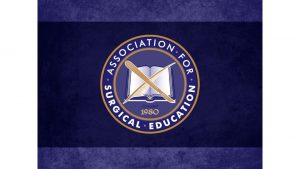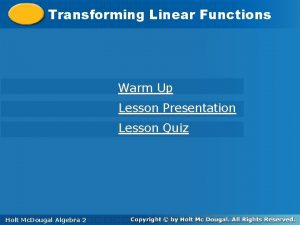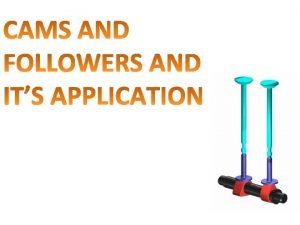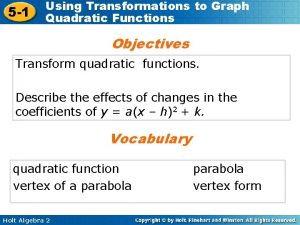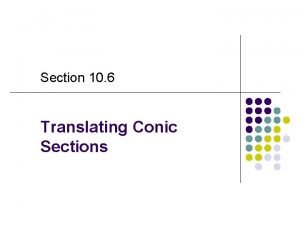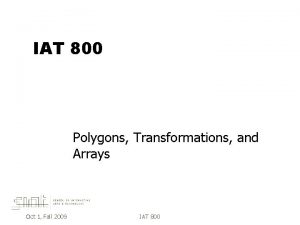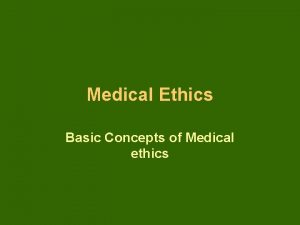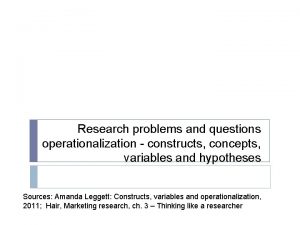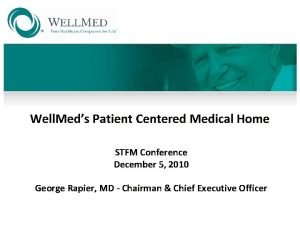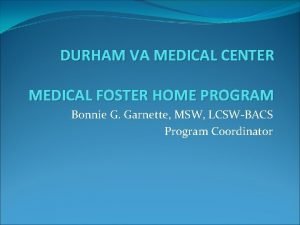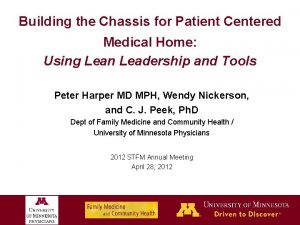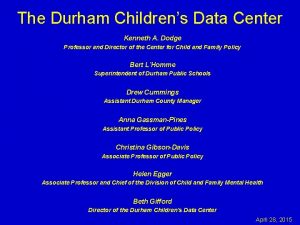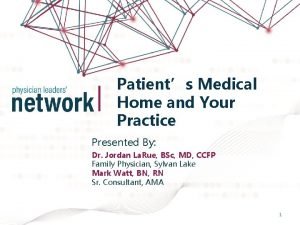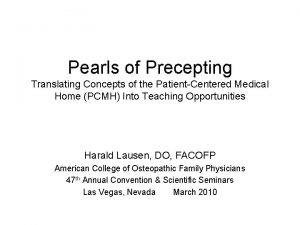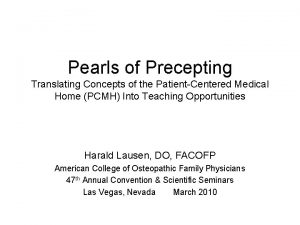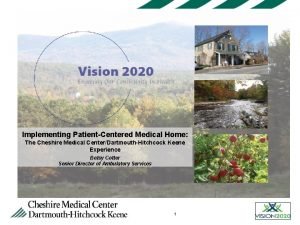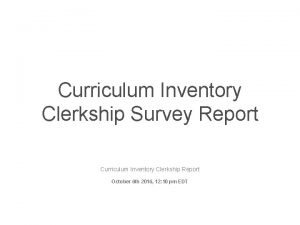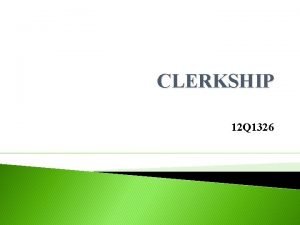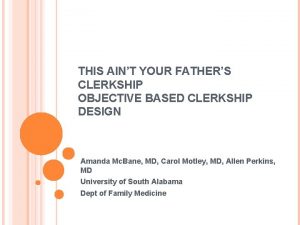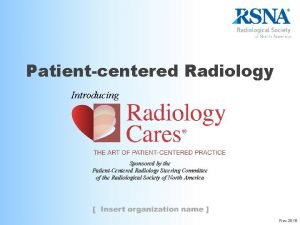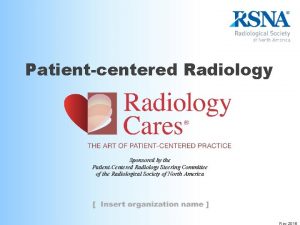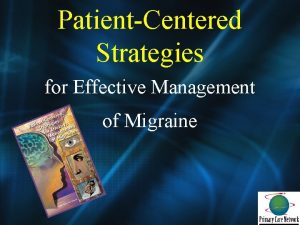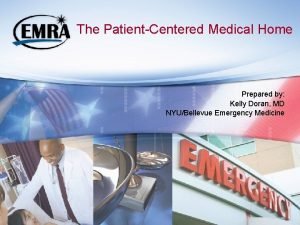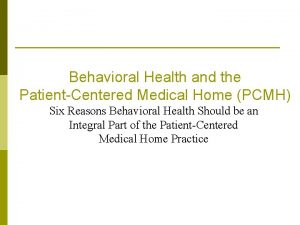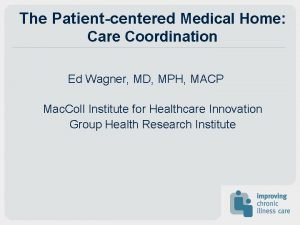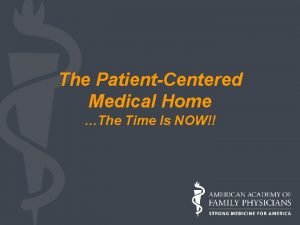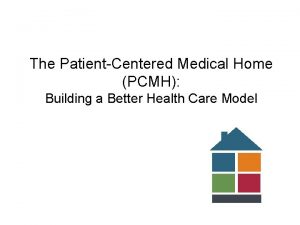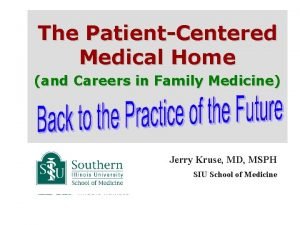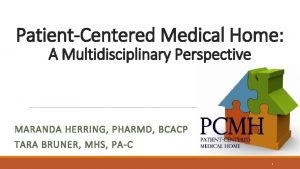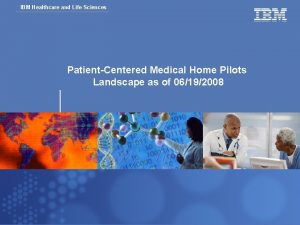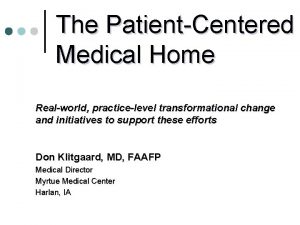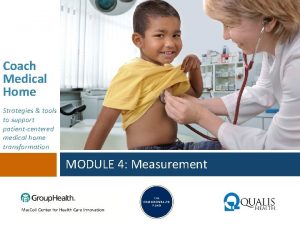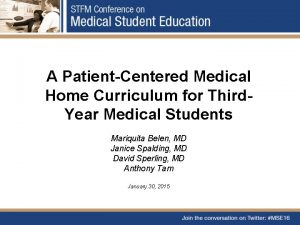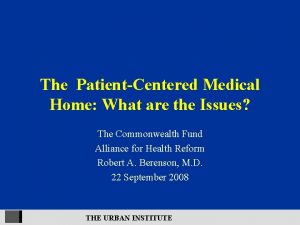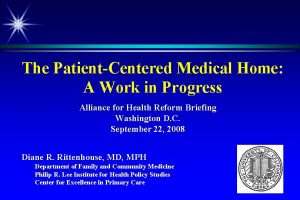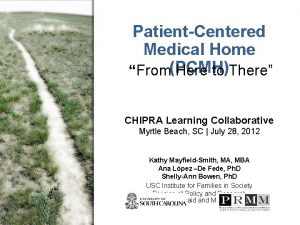The PatientCentered Medical Home Translating Concepts into Clerkship










































































- Slides: 74

The Patient-Centered Medical Home: Translating Concepts into Clerkship Curriculum Society of Teachers of Family Medicine 36 th Annual Predoctoral Education Conference Jacksonville, FL January 31, 2010

Southern Illinois University School of Medicine Department of Family & Community Medicine Predoctoral Education Harald Lausen, DO, MA Amber Barnhart, MD Tracey Smith PHCNS-BC, MS

Family & Community Medicine Clerkship • • • Preceptor-Based; 29 years 160+ Preceptors in Illinois All areas of Illinois 50 -60 Preceptors per Year 8 rotations per Year Groups of 7 -12 Students

Family & Community Medicine Clerkship Schedule • 6 Week Clerkship Rotations • Orientation – 4 days during week 1 • Preceptorship – 4 weeks • Evaluation – 3 days during week 6

References - FMDRL. ORG The Patient-Centered Medical Home: A Focus for the Family Medicine Clerkship STFM 2008 Annual Spring Conference The Patient-Centered Medical Home: Lessons Learned From A New Family Medicine Clerkship Curriculum STFM 2009 Annual Spring Conference

Objectives for Today After the completion of this seminar, participants will be able to: • List the general principles and concepts of the Patient-Centered Medical Home. • Relate components of Healthy People 2010, the Future of Family Medicine Report, and the Family Medicine Clerkship Core Content Curriculum Project to the concepts and characteristics of the Patient. Centered Medical Home. • Discuss and consider feedback and outcomes of our current curriculum. • Capture several concepts that could be implemented into their own clerkship curriculum.

Disclaimer • I will break the typical rules of powerpoint slides to provide a larger quantity of information. • These slides are there for your reference.

The Patient-Centered Medical Home: History • 1967 - Pediatrics: “Medical Home” • 2002 - Family Medicine: “Personal Medical Home” • 2006 - Internal Medicine: “Advanced Medical Home” • 2004, 2005 - Evidence-based Characteristics Defined Characteristics of primary care practices that improve outcomes and lower costs published by Starfield and colleagues • 2006, Sept 28 - Broad Legislative Support Rep. Nathan Deal, Chair, House Energy & Commerce Subcommittee on Health, noted broad legislative support for Medical Home concept • 2007, Feb - AOA, AAFP, ACP, AAP publish “Joint Principles of the Patient-Centered Medical Home” http: //www. medicalhomeinfo. org/Joint%20 Statement. pdf

Future of Family Medicine Project http: //www. annfammed. org/cgi/reprint/2/suppl_1/s 3 • • • Patient-Centered Care Whole-Person Orientation Team Approach Elimination of Barriers to Access Information Systems Redesigned Offices Focus on Quality and Safety Enhanced Practice Finance New Model / Basket of Services

Practice Characteristics Associated With Improved Health Outcomes and Lower Cost The Patient-Centered Medical Home • • First Contact Care Patient-focused Care over time Comprehensive Care Coordinated and Integrated Care • Family Orientation • Community Orientation • Cultural Competence Starfield & Shi: Pediatrics, 2004; 113: 1493 -99 Starfield et al: Milbank Quarterly 2005; 83: 457 -502

Joint Principles of the Patient-Centered Medical Home (AAFP, AAP, ACP, AOA) http: //www. aafp. org/online/etc/medialib/aafp_org/documents/policy/fed/jointprin ciplespcmh 0207. Par. 0001. File. tmp/022107 medicalhome. pdf • • • Personal Physician Directed Medical Practice Whole Person Orientation Coordinated / Integrated Care Hallmarks of Quality & Safety – EBM, CQI, HIT, Patient Expectations • Enhanced Access to Care • Appropriate Payment

Patient-Centered Medical Home 1 Objective in 10 Parts • • • Core Concepts of Family Medicine Advanced EBM Preventive Medicine Health Information Technology Health Systems Practice Management Chronic Disease Model Community Oriented Primary Care Coordination / Integration of Care Critical Thinking

Family Medicine Clerkship Curriculum http: //www. stfm. org/documents/fmcurriculum%28 v 3%29. pdf (Previously the Family Medicine Clerkship Core Content Curriculum Project) • • Principles of Family Medicine Key Characteristics of Family Physicians Core Presentations – Acute Core Presentations – Chronic Characteristics of Chronic Disease Management by FPs Characteristics of Preventive Care by FPs Core Health Promotion Conditions for Adults Core Health Promotion Conditions for Children and Adolescents

Family Medicine Clerkship Curriculum Principles of Family Medicine • • • The Biopsychosocial Model Comprehensive Care Continuity of Care Contextual Care Coordination / Complexity of Care

Family Medicine Clerkship Curriculum Key Characteristics of Family Physicians • Prior Knowledge of the Patient • Care for a Heterogeneous Patient Population • Multiple Settings with Different Diagnostic Prevalence • Multi-Purpose Visits • Staged Diagnostic Approach • Opportunity for Follow-up Care

Family Medicine Clerkship Curriculum Core Acute Topics (20) • • • Abdominal Pain Chest Pain Cough Dementia Depression Dizziness Dyspnea / Wheezing Dysuria Fever Headache • • • Joint Pain Leg Swelling Low Back Pain Pregnancy Presentation, Initial Skin Lesions, Common Skin Rashes, Common Upper Respiratory Symptoms Urinary Symptoms, Male Vaginal Bleeding, Abnormal Vaginal Discharge

Family Medicine Clerkship Curriculum Core Chronic Topics (14) • • Anxiety Arthritis Asthma / COPD Back Pain, Chronic Coronary Artery Disease Depression Diabetes, Type 2 • • Heart Failure Hyperlipidemia Hypertension Multiple Chronic Illnesses Obesity Osteoporosis Substance Use / Abuse

Family Medicine Clerkship Curriculum Characteristics of Chronic Disease Management by FPs • Chronic Disease Management Knowledge and Skill • Attention to Co-Morbidities • Continuity Context • Relationship with the Patient • Patient Empowerment and Self-Management Support

Family Medicine Clerkship Curriculum Characteristics of Preventive Care by FPs • • Evidence-Based Individualized Opportunistic Prioritized

Family Medicine Clerkship Curriculum Core Health Promotion Conditions for Adults • • Breast Cancer Cervical Cancer Colon Cancer Coronary Artery Disease Depression Diabetes, Type 2 Fall Risk in Elderly Patients • Intimate Partner and Family Violence • Obesity • Osteoporosis • Prostate Cancer • STIs • Substance Use / Abuse

Family Medicine Clerkship Curriculum Core Health Promotion Conditions for Children and Adolescents • • • Diet / Exercise Family / Social Support Growth and Development Hearing Lead Exposure • • • Nutritional Deficiency Potential for Injury Sexual Activity Substance Use Tuberculosis Vision

Southern Illinois University School of Medicine Department of Family & Community Medicine Predoctoral Education Year 3 Family Medicine Clerkship

References - FMDRL. ORG Preceptor and Medical Student Perceptions: Using an Online Evidence-Based Database at the Point of Care STFM 2010 Annual Predoctoral Conference Electronic Health Communication: An Educational Program for This Cornerstone of the Patient-Centered Medical Home STFM 2009 Annual Spring Conference

Day 1 Orientation / Curriculum • • Welcome Health Policy / PC-MH / FM Careers Clerkship Curriculum & Policies Evidence-Based Medicine at the Point of Care Concepts of Family Medicine Introduction to Patient Emails Leadership for Medical Teams Impact of Depression on Chronic Disease (new)

Day 2 Orientation / Curriculum • Pillars of Medical Ethics / Informed Consent • Health Literacy / Shared Decision-Making / Patient Education (new) • Population Health / Principles of Prevention • Lunch / Chronic Pain Management • Assessment of Knee Injuries • Community Oriented Primary Care

Day 3 Orientation / Curriculum • • • Introduction to Dermatology Procedures (new) Lunch / Basic Practice Management Advanced Pub. Med Search Global Perspectives on Determinants of Healthcare

Day 4 Orientation / Curriculum • Diabetes Quality Improvement / Chronic Care Model (new) • Common Clinical Procedures • Feedback / Final Instructions • Travel in Afternoon to Preceptor Sites

Comparable Results “Usefulness of Session” Session Class of 2008 (n=57) Class of 2009 (n=63) Class of 2010 (n=67) Intro / PCMH 3. 97 3. 92 EBM 3. 92 3. 13 3. 91 Pub. Med 3. 49 3. 41 Core Concepts 4. 12 3. 90 4. 19 ECG / Lab 4. 75 4. 54 4. 47 Knee / Ankle 4. 57 4. 61 Practice Manage n/a 4. 48 4. 08

New Session Results “Usefulness of Session” Session Class of 2010 Sample Size Population Health / Prevention 3. 66 N=67 Community Oriented Primary Care 3. 41 N=25 Patient Email 3. 87 N=67 Legal and Ethical Issues 4. 03 N=67 Intro to Leadership 3. 72 N=67 Primer in Pain Management 4. 06 N=67 Intro to Dermatology 4. 50 N=32 Global Perspectives on Healthcare 3. 78 N=23

Assignments • Logbook – 30 Diagnoses (acute & chronic) • Essential Evidence + (Info. Poem) POC sheet • Critical Appraisal of Clinical Article – Pub. Med Search Strategy • HENT, Pulm, Knee Observed Exams • Quality Improvement Sheet (Diabetes) • Reflective PC-MH Sheet • Patient Emails • Distance Learning / Reading

Assignment Results “Usefulness of Assignment” Assignment Class of 2009 (N=56) Class of 2010 (N=60) PCMH Reflection N/A 2. 96 Diabetes QI N/A 3. 94 COPC N/A Changed to Lecture Emails N/A 3. 93 Essential Evidence 3. 24 3. 89 Critical Appraisal 3. 26 3. 94 Discussion Group 3. 65 4. 28

Day 1 Testing • • • Welcome Back Experience Debriefing Ess Evid + (Info. Poem) POC worksheet Critical Appraisal of Clinical Article Submission (not reviewed as group) – Reflective PC-MH Sheet – QI Sheet • Testing Stations (8 stations)

Day 1 Testing • Testing Stations (8) – – – – Perinatal Care (Labs, Testing, Symptoms) Well Child (Development, Immunizations, Guidance) Legal / Ethical Principles Population Health Principles Practice Management Community Oriented Primary Care Health Literacy Diabetes Management / Chronic Care Model

Day 2 Testing • NBME Shelf Test • Simulated Patients (2 cases) – 1 Expanded Feedback – 1 Short Feedback and CCX – Cases • Headache / Depression • Dyspnea / CHF / CAP

Day 3 Testing • Testing Stations (5) – Family Systems (Reflection) – Patient Education / Decision-Making (Hypertension & Diabetes) – Geriatric / Rural (Assessment, Prevention, Core) – Email (Computer Station) – Pub. Med Search (Computer Station) • Lunch / Debriefing

OSCE Stations “Usefulness of Testing” Station Class of 2009 (n=56) Class of 2010 (n=60) PCMH N/A 3. 20 Preventive Medicine N/A 3. 86 Practice Management N/A 3. 35 Well Child 3. 59 3. 79 Legal / Ethical N/A 3. 45 ECG 3. 46 3. 78 Lab 3. 76 3. 98 Email (computer) N/A 3. 79 Pub. Med (computer) 2. 74 3. 31 Knee N/A 3. 48 Perinatal 3. 89 3. 73 Geriatric (proctor) 3. 85 4. 07 Psychosocial (proctor) 3. 59 3. 93 Patient Education (proctor) 3. 89 4. 14

Assessment “Usefulness of Testing” Assessment Class of 2009 (N=56) Class of 2010 (N=60) SP / CCX 4. 06 4. 20 NBME Shelf 3. 51 3. 56

Logbook Requirements (30) • • • • URI/Sinusitis/Pharyngitis (10) General Exam/Cancer Screening/Immunization (4) Menopause/Menstrual Disorder (2) Diabetes (8) Asthma / Wheeze (4) Osteoporosis (2) Hyperlipidemia (8) Abdominal Pain (2) Otitis Media (2) Hypertension (8) Allergies / Rhinitis (2) Pneumonia/Bronchitis (2) Anxiety (4) Arthritis (2) • • • • Chest Pain / CAD (2) Depression (4) Tobacco/Smoking (2) CHF / Edema (2) GERD/Dyspepsia (4) Dementia / Delerium (2) COPD / Cough (2) Headache (4) Fatigue (2) Stroke / CVA / Vertigo (2) Obesity / Metabolic (4) Knee / Shoulder Pain (2) UTI/Vaginal Symptom (2) Rash/Lesion/Acne (4) Lumbar Pain (2) Substance Use / Abuse (1)

Essential Evidence Plus - Instructions: The Essential Evidence Plus worksheet is to be completed during a patient visit (at the point of care). You will have your preceptor review the worksheet, complete the two questions, and sign at the bottom of the page. Bring the completed worksheet with you to discuss on the first day of exams (week 6 of clerkship). The worksheet will be collected and counts as 2. 5% of your final clerkship evaluation.

Evidence-Based Medicine at the Point of Care Essential Evidence Plus Worksheet Student Name________________ Preceptor Name________________ Date_____ Class of_______ Rotation #_____ Site____________________ Clinical Question______________________________________ Search Terms: ____________________ Level of Evidence: ___________ Briefly describe the clinical scenario leading to the question: Info. Poem used: ______________________________________ Decision/Intervention: ____________________________________ Time required to find information and formulate decision: ____ minutes Total number of Info. Poems reviewed prior to finding the Info. Poem used: ____ Did you learn new clinical information by using this Info. Poem? Did applying the Info. Poem affect patient care? Explain: PRECEPTOR Was an appropriate Info. Poem found for the clinical question? Did the student’s findings affect patient care? YES YES NO NO Comments: Preceptor Signature____________________ Date____________ Please contact the SIU Department of Family and Community Medicine at 217 -545 -0200 for additional information regarding the use of Essential Evidence Plus (formerly Info. Poems/Info. Retriever).

EVIDENCE-BASED MEDICINE CRITICAL APPRAISAL ASSIGNMENT 1. Develop a clinical question from a real patient that you encounter during your FCM clerkship. (This question does not need to be related to the Essential Evidence Plus question) 2. Perform a Pub. Med search using the skills reviewed during orientation. (The initial Pub. Med 3. search strategy is due on the third Friday of the clerkship --- see Pub. Med search instructions for details). 4. Identify a primary clinical article that answers your clinical question (do not use a review article or a critical appraisal paper). 5. Critically appraise the article using the appropriate questions (see EBM Critical Appraisal of Literature pdf for appropriate questions). 6. Present a critical appraisal of the article that answers your clinical question --- on the first day of exams (week 6 of clerkship). 7. Provide the following items to Kim Colgan (electronic versions of these items preferred): (1) critical appraisal of the article (2) copy of the article you present (3) copy of your modified Pub. Med search strategy

Pub. Med Search Strategy 1. Identify a clinical question for a common clinical presentation. 2. Conduct a systematic literature search using Pub. Med. 3. Copy and Paste your Search Strategy from the Pub. Med History screen into a Word document. The Search History is found on the Advanced Search screen. When copying the History, only copy the history, not the whole Advanced search screen. 4. Choose three to five references that answer your search question. 5. Summarize your findings from those references into a 100 word or less answer to your clinical question. (These references may also be used for your annotated bibliography). 6. Include your search strategy, the 3 -5 references you selected and the 100 word summary to your clinical question in a document formatted like the one below. Send the document as an attachment via email to Rhona Kelley (rkelley@siumed. edu) 7. Your assignment will be scored and returned to you with feedback on how to improve your Pub. Med search. This feedback should be incorporated into your final search strategy for the EBM common problem presentation

Quality Improvement Worksheet (Diabetes) Instructions: Show this assignment to your preceptor. Identify a patient with diabetes and perform a chart review. Complete the Diabetes Quality Improvement Worksheet while you are doing the chart review. The purpose of this assignment is to familiarize you with the general approach of chart review as a fundamental step toward quality improvement.

Quality Improvement Worksheet – Diabetes (Type 2) Patient Gender: M F Age_____ EHR: Y N Please circle the appropriate answer if the information is recorded in the chart. Vital Signs and Weight Recorded (each visit) BMI / Weight Loss Discussed (last year) Diet Education Reviewed (last year) Exercise Discussed (last year) Tobacco Cessation Discussed (last year if applicable) Dilated Eye Exam Referral (last year) Influenza Vaccination Offered (last year) Urine Microalbumin Ordered (last year) Foot / Neuro Exam Completed (last year) Fasting Lipid Panel Ordered (last year) Hemoglobin A 1 C Ordered (last 6 months) BP at Goal (<130/80) Hg. A 1 C at Goal (<7) LDL at Goal (<100) HDL at Goal (>40 men, >50 women) Patient on ACE/ARB (or contraindication noted) Patient on Aspirin (or contraindication noted) Student Signature___________________________ Preceptor Signature__________________________ Y Y Y Y Y N N N N N

Reflective PC-MH Writing • Introduction: The purpose of this assignment is to promote the recognition of specific characteristics of the Patient-Centered Medical Home (discussed during orientation) while you are working with your preceptor. These topic areas are some of the characteristics of personal physicians that have been associated with improved health outcomes and lower costs. • Instructions: Your assignment will be to record personal reflections on three physician/practice characteristics (listed below) that you experience/identify during the clerkship. Each reflection should be in a typed electronic format and no longer than one page. This assignment will be collected during week six of the clerkship. •

Reflective PC-MH Writing Please provide reflections on each of the three following characteristics: • Patient-Focused Care Over Time (the degree to which the practice emphasizes patient-focused care, rather than disease-focused care; and longitudinal care, rather than episodic care) • Coordinated/Integrated Care (the degree of integration of care among health professionals and staff, both within the PC-MH and with outside organizations and consultants) • Community Orientation (the degree to which the practice assesses the needs of the community, designs interventions, and measures outcomes) OR • Cultural Competence (the degree to which the biopsychosocial model is employed and health belief models are addressed)

Distance-Learning Assignment • 4 Cases w/ Readings (USPSTF / AFP / Review) Case Instructions You will be given a brief case presentation (see below). Each case represents a special patient population with multiple medical issues for consideration. Specific reading assignments for each case are included in the electronic case folder. Reading assignments should be completed prior to discussion group meeting on the following Tuesday. Discussion group will be held in the chat room at 3 pm on Tuesday afternoons on the Family and Community Medicine Blackboard page. See the Discussion Group folder for further details.

CASE 1: 25 y/o Female - Prenatal Visit Vitals: Ht: 5’ 8” WT: 135# P: 65 R: 16 BP: 114/70 Susan Phillips is a 25 y/o G 2 P 1001 patient who presents for her first prenatal visit. She also complains of a chronic non-productive cough for the last 4 weeks. She has a prior medical hx of asthma and tobacco abuse (8 pack years). She denies any other symptoms. Her family history is positive for hypertension, hyperlipidemia, and diabetes. Currently, she lives at home with her 1 year old son (Tyler) and her boyfriend of 2 years. There is a copy of a recent ED visit for physical abuse in her chart. Readings for Susan Phillips Asthma Guidelines Evidence Based Prenatal Care (Parts 1&2) STD Screening Gestational Diabetes Screening Family Violence Screening Tobacco Counseling (AFP 2009) (AFP 2005) (AFP 2007) (AIM 2008) (USPSTF 2004) (USPSTF 2009)

CASE 2: 1 y/o Male - Well Child Visit Vitals: Ht: 50% Wt: 95% HC: 60% Tyler Phillips is a 1 y/o male who presents for a well child visit with his mother. There are no complaints. Tyler is an obese child acting normally and being playful. Up to now his development has been normal and his immunizations are up to date. He has no previous medical history. His family history is positive for hypertension, diabetes, and asthma. He is currently eating table foods and drinks about 5 sippy cups of juice daily. His mother also notes that he loves candy. He lives with his mother (Susan) and her boyfriend. There is tobacco exposure at home. Readings for Tyler Phillips Childhood Obesity and CV Risk Childhood Obesity Screening Dental Caries Screening Lead Screening Immunization Schedule Pediatric Development Chart ) (AFP 2008) (USPSTF 2005) (USPSTF 2004) (USPSTF 2006) (CDC 2009) (Ewart)

CASE 3: 60 y/o Grandmother - Acute Visit Vitals: Ht: 5’ 5” Wt: 198 P: 76 R: 21 BP: 142/84 Betty Phillips is a 60 year old grandmother who presents with exertional dyspnea for the last four weeks. She notes difficulty with doing her normal level of activity. She denies chest pain. She has a prior medical hx of hypertension, hyperlipidemia, and obesity. Her family history is positive for hypertension, diabetes, asthma, stroke, breast cancer, and coronary artery disease. Her husband presents with her today and quietly tells you he is concerned about her memory. Her chart reveals it has been over 1 year since her last visit. Readings for Betty Phillips Acute Dyspnea Cardiovascular Disease in Women Breast Cancer Screening Cervical Cancer Screening Dementia Screening Depression Screening Osteoporosis Screening ) (AFP 2003) (AFP 2006) (USPSTF 2005) (USPSTF 2003) (USPSTF 2002)

CASE 4: 68 y/o Grandfather – Home Visit Vitals: Ht: 5’ 6” WT: 157# P: 82 R: 16 BP: 140/82 Joe Mason is a 68 year old grandfather who is homebound due to agoraphobia and post-traumatic stress disorder. He called the office with a complaint of intermittent episodes of dizziness. He has never had similar symptoms. He has a prior medical hx of hypertension, hyperlipidemia, osteoarthritis, and chronic back pain. His family history is positive for hypertension, diabetes, asthma, stroke, breast cancer, and coronary artery disease. He lives alone. His sister (Betty Phillips) and niece (Susan Phillips) help him with groceries, supplies, etc. You typically do home visits for this patient. Readings for Joe Mason Chronic Low Back Pain Osteoarthritis Geriatric Patient Home Visit Colon cancer Screening Prostate Cancer Screening Geriatric Cancer Screening (AFP 2009) (AFP 2002) (AFP 2000) (AFP 1999) (AFP 2008)

Patient Email • Instructions: • The goal of this assignment is to practice application of the patient email communication guidelines (presented in orientation) through simulated patient emails • Each week you will receive an email from the patient or patient’s family member that corresponds with the patient case and reading for that week of the clerkship. • You will need to reply to this email in an appropriate manner prior to the Tuesday Discussion Group for that case. Emails not received prior to the Discussion Group will be disregarded. • The email reply should be returned to the original sender. • You should assume that you are using an approved system for email use and that your patient has agreed to rules you provided to them about use of email.

Email Cases Challenge • Case 1 “As you know my boyfriend and I had some trouble in the past. I was wondering what my cultures from my prenatal visit showed. ” • • • Content HIPAA Lay Language • Case 2 “Tyler has an appointment next week for his 1 year check-up. I was wondering if he is due for shots at that time? ” • • Content Lay Language • HIPAA • Urgent Issue • • Case 3 "My wife has an appointment with you next week and I am concerned with some memory loss she is having. She just doesn't seem to be herself. Did you notice any problems with her memory last year when you saw her? Can you provide her with some medication to help with this? Please don’t tell my wife that I contacted you. She seems very sensitive about her recent memory issues. ” Case 4 "I am so sorry to bother you but I wanted to let you know this before my home visit scheduled next Tuesday. This morning after I got up I started a little blurrred vision and almost passsed out. The room seemed to spin. I am better now but I know how you like you to know everything for our visits. Should I be worried? See you later week. ”

PCMH / Health Policy Goal: To develop an understanding of the patient-centered medical home. Students will: • Recognize the characteristics of practices that are associated with improved health outcomes and lower costs: first contact care, patient-focused care over time, comprehensive care, coordinated/integrated care, family orientation, community orientation, and cultural competence. • Become familiar with the components of the “Joint Principles of the Patient. Centered Medical Home”: personal physician, physician-directed medical practice, whole-person orientation, coordinated/integrated care, quality and safety, enhanced access, and appropriate payment. • Become familiar with the health system and policy characteristics associated with improved health outcomes. • Recognize the relationship between the physician workforce and health outcomes. • Recognize the relationship of quality and cost of health care to the physician workforce.

EBM at the Point of Care Goal: To review and consider the application of evidence–based medicine principles. Students will: • Review the basic principles of evidence-based medicine. • Develop an appreciation for the practical uses and limitations of EBM. • Understand the formulation of answerable and searchable clinical questions. • Develop skills in critically appraising and applying the medical literature.

Core Concepts in Family Medicine Goal: To become familiar with the core concepts of Family Medicine Students will: • Recognize the core concepts of Family Medicine: Comprehensive Care, Communication, Continuity (cradle to grave), Community-Health/Community Agencies and Resources, Continuous Quality Improvement, Concordance and Collaboration, Compassion, Cost-Effectiveness, Culturally Competence, and Confidentiality • Participate in all group discussions, as well as display initiative, integrity, and professional/personal maturity. • Relate basic medical and scientific principles to the clinical vignette and case presentation while also thinking about the various community agencies available for this case scenario. • Incorporate concepts of Evidence-Based Medicine into the discussion and learning issues. • Become familiar with the differential diagnosis of vesicular rash; diagnosis, medication management and treatment goals for high cholesterol, high blood pressure, diabetes and metabolic syndrome.

Introduction to Patient Emails Goal: To become familiar with the guidelines for patient email communication. Students will: • Recognize the emerging importance of patient-physician emailing. • Recognize appropriate and inappropriate topics and issues within patient emails. • Understand the definition of Patient-physician email • Become familiar with key structures/policies for implementation of safe, confidential, and efficient email communication. • Recognize the impact of implementing such a process on nursing and office staffs.

Leadership for Medical Teams Goal: To introduce the full-range leadership model and principles of conflict resolution. Students will: • Recognize that physicians are leaders within their team, office, group, specialty, profession, etc. • Become familiar with the full range leadership model. • Become familiar with the characteristics of transformational leadership. • Recognize other important information for the empowerment of followers.

Impact of Depression on Chronic Disease Goal: To introduce the association of depression and chronic diseases Students will: • Understand the association of depression and anxiety with medical symptom burden in patients with chronic medical illness • Become familiar with the other management issues related to chronic disease

Pillars of Medical Ethics / Informed Consent Goal: To review basic ethical principles and consider the requirements of informed consent Students will: • Understand the fundamental pillars of ethical medical practice: beneficence, non-maleficence, patient autonomy, and distributive justice. • Become familiar with the requirements for informed consent: procedure, risks, benefits, alternatives • Discuss basic legal principles that flow from these topics. • Recognize the limitations and clinical applications of the principles discussed.

Health Literacy / Shared Decision-Making / Patient Education Goal: To review basic concepts of health literacy, shared decision making, health belief model and essential points of patient education Students will: • Understand the importance and how to assess the health literacy levels of patients • Understand the basic concepts of shared decision making and how to apply to patient encounters • Understand the concepts of the health belief model and how the model can be used in patient education • Identify the essential key points of patient education

Population Health / Principles of Prevention Goal: To review specific epidemiologic calculations and become familiar with components of population health. Students will: • Define and calculate sensitivity, specificity, positive and negative predictive values. • Describe three ways environmental or population factors can adversely affect health (specific examples). • Define COPC and list two pros and two cons. • Explain the purpose of medical surveillance and two specific examples. Describe some contributing factors to disease outbreaks.

Chronic Pain Management Goal: To introduce basic principles of pain management in primary care. Students will: • Become familiar with the definitions of common pain management terms. • Review basic pharmacologic approaches to pain management including the WHO pain pyramid, appropriate uses, and adverse effects. • Become familiar with the Federation of State medical Boards “Model Policy for the Use of Controlled Substances for the Treatment of Pain. ” • Become familiar with the components of a Pain management Agreement • Understand the 4 A’s of Pain management: Analgesia, Activities of Daily Living, Adverse effects, Aberrant behavior

Assessment of Knee Injuries Goal: To become familiar with treatment of lower extremity injuries. Students will: • Become familiar with clinical approach to the lower extremity. • Become familiar with Ottawa Knee Rule. • Be able to evaluate patients with anterior knee pain. • Be able to evaluate patients with an acutely effused knee. • Be able to perform an anatomically-based physical exam of the knee.

Community Oriented Primary Care Goal: To introduce basic principles of community oriented primary care. Students will: • Be able to explain what is meant by “caring for the patient not in the room” • Compare individual clinical care to COPC population care • Identify the 5 steps in the COPC process

Dermatology Introduction to Dermatology Students will: • Be able to define basic dermatology terminology • Be able to describe dermatology findings accurately • Identify some common dermatologic conditions Dermatologic Procedures Students will become familiar with: • Various techniques for anesthetizing surgical sites • Various techniques for incisions, biopsies, and lesion removal

Basic Practice Management Goal: To introduce basic concepts of practice management. Students will: • Become familiar with basic types of health insurance. • Become familiar with basic coding and billing terminology. • Recognize variations in physician reimbursement. • Recognize variations in physician liability insurance. • Recognize variations in basic types of physician employment.

Advanced Pub. Med Search Goal: To review and advance the student’s ability to use Pub. Med. Students will: • Understand the benefits and disadvantages of using index terms, such as the Medical Subject Headings (Me. SH) vocabulary versus using keyword and free text searching methods • Review specific tools such as search limits, my NCBI, and previous searches. • Recognize the differences between Pub. Med, Cochrane Library, and Essential Evidence Plus • Develop efficient search skills and recognize the appropriate use for each resource and/or tool.

Global Perspectives on Determinants of Healthcare Goal: To introduce relevant determinants of health at the global, national and state levels and provide an analytical framework to inform advocacy at the individual and population levels. Students will: • Become familiar with at least three models to conceptualize determinants of health and disease • Be able to describe social determinants of health and how they relate to the conceptual models • Be able to identify the unique challenges that gender poses as a social determinant • Compare trends in HIV/AIDS at the global, national and state levels and governmental responses • Identify at-risk populations of Illinois • Describe the distinct challenges for advocating individual and population health

Diabetes Quality Improvement / Chronic Care Model Goal: To introduce diabetic care, quality improvement for diabetes care and the chronic care model Students will: • Understand the key principles of the Chronic Care Model and how it applies to the care of the patient with diabetes. • Explain the findings needed to diagnose DM 2. • Identify the various goals for patients with diabetes (i. e. A 1 c, lipids, BP’s, etc. ) • Understand the known complications of diabetes, how to monitor for them, and how to lower risk of getting them. • Explain how and when to use various medications for diabetes. • Understand the proper use of statin therapy and how to monitor for sideeffects and adverse reactions.

Group Discussion

Feedback / Questions

Thank You!

Additional Information Power. Point and other documents can be found at: FMDRL. org
 Lcme clerkship requirements
Lcme clerkship requirements Translating strategy into action
Translating strategy into action Translating a sentence into a one-step equation
Translating a sentence into a one-step equation 1-5 translating sentences into equations answer key
1-5 translating sentences into equations answer key Translating word problems into equations
Translating word problems into equations Translating english into logical expressions
Translating english into logical expressions Concepts heading home
Concepts heading home Translating quadratic functions
Translating quadratic functions Translating expressions
Translating expressions Translating linear inequalities
Translating linear inequalities Translating equations
Translating equations Two less than a number
Two less than a number Clamshell door system
Clamshell door system Verbal expression math
Verbal expression math Graph transformations
Graph transformations Lesson 6-4 transforming linear functions
Lesson 6-4 transforming linear functions Relative motion of two particles using translating axes
Relative motion of two particles using translating axes Friedeich
Friedeich Translate x + 32 a verbal phrase
Translate x + 32 a verbal phrase Translating quadratic functions
Translating quadratic functions Tornado reverse thrust
Tornado reverse thrust Translate
Translate Exponential function transformations
Exponential function transformations Translating research findings to clinical nursing practice
Translating research findings to clinical nursing practice Translation of financial statements
Translation of financial statements Translating between tables and expressions
Translating between tables and expressions Translating contracts
Translating contracts Cam meaning
Cam meaning Translating quadratic functions
Translating quadratic functions Translate word equations to chemical equations
Translate word equations to chemical equations Translating conic sections
Translating conic sections Translating ore polygons
Translating ore polygons Home care
Home care Perbedaan home care dan home visit
Perbedaan home care dan home visit Mobile home exchange
Mobile home exchange Flower plural
Flower plural Softly and tenderly jesus is calling
Softly and tenderly jesus is calling Oak springs rv park
Oak springs rv park Let's go to your house
Let's go to your house Jr rabbin imam pretre
Jr rabbin imam pretre She said that, home economics stands for the ideal home.
She said that, home economics stands for the ideal home. Home sweet home survive items
Home sweet home survive items Confidentiality in medical ethics
Confidentiality in medical ethics Introduction to medical ethics
Introduction to medical ethics Concepts constructs and variables
Concepts constructs and variables Converting concepts into variables
Converting concepts into variables Patient centered medical home conference
Patient centered medical home conference Medical foster home
Medical foster home Patient centered medical home
Patient centered medical home Medical foster home program
Medical foster home program Your medical home
Your medical home Hình ảnh bộ gõ cơ thể búng tay
Hình ảnh bộ gõ cơ thể búng tay Ng-html
Ng-html Bổ thể
Bổ thể Tỉ lệ cơ thể trẻ em
Tỉ lệ cơ thể trẻ em Chó sói
Chó sói Glasgow thang điểm
Glasgow thang điểm Alleluia hat len nguoi oi
Alleluia hat len nguoi oi Môn thể thao bắt đầu bằng từ chạy
Môn thể thao bắt đầu bằng từ chạy Thế nào là hệ số cao nhất
Thế nào là hệ số cao nhất Các châu lục và đại dương trên thế giới
Các châu lục và đại dương trên thế giới Công của trọng lực
Công của trọng lực Trời xanh đây là của chúng ta thể thơ
Trời xanh đây là của chúng ta thể thơ Cách giải mật thư tọa độ
Cách giải mật thư tọa độ 101012 bằng
101012 bằng độ dài liên kết
độ dài liên kết Các châu lục và đại dương trên thế giới
Các châu lục và đại dương trên thế giới Thể thơ truyền thống
Thể thơ truyền thống Quá trình desamine hóa có thể tạo ra
Quá trình desamine hóa có thể tạo ra Một số thể thơ truyền thống
Một số thể thơ truyền thống Cái miệng nó xinh thế chỉ nói điều hay thôi
Cái miệng nó xinh thế chỉ nói điều hay thôi Vẽ hình chiếu vuông góc của vật thể sau
Vẽ hình chiếu vuông góc của vật thể sau Thế nào là sự mỏi cơ
Thế nào là sự mỏi cơ đặc điểm cơ thể của người tối cổ
đặc điểm cơ thể của người tối cổ V cc
V cc
